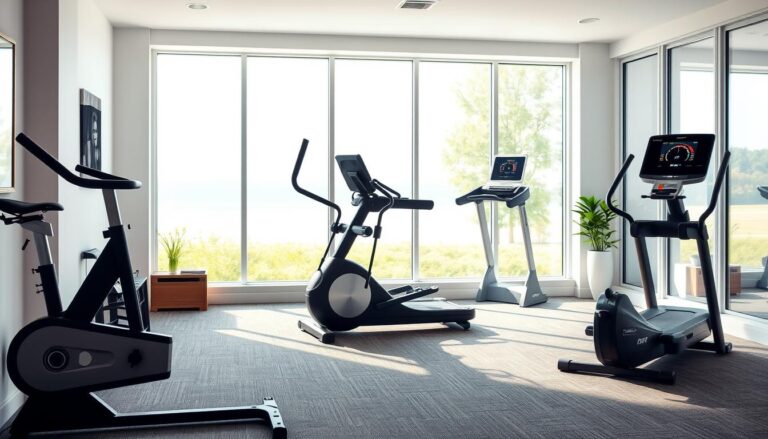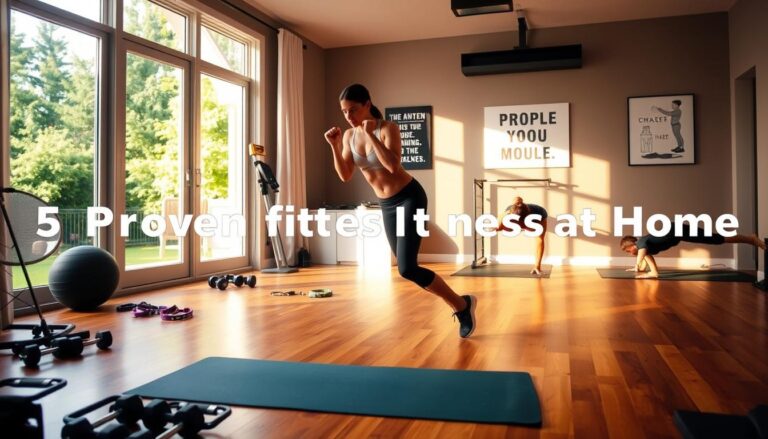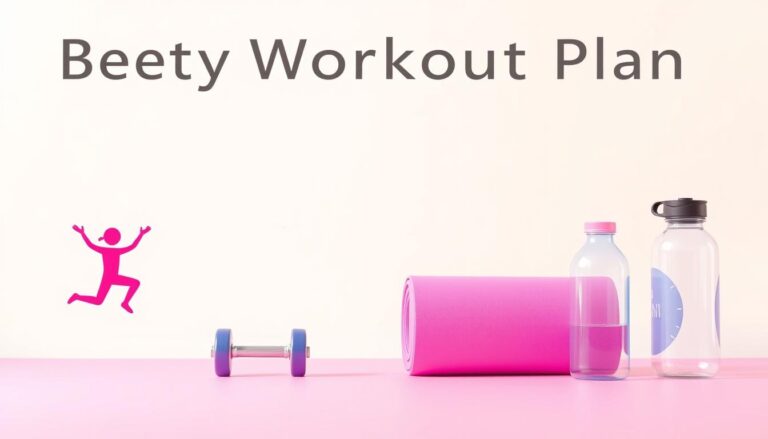Busy Professionals: Designing the Perfect Workout Routine
In today’s fast world, keeping up with a workout routine is tough for busy pros. But, a good effective fitness plan can really help.
A well-thought-out workout plan fits your busy life. It’s key to know what’s important to you. Then, make an effective fitness plan that matches your life.
This way, you can reach your fitness goals without giving up your job.
Key Takeaways
- Assess your schedule to create an effective workout plan.
- Prioritize your fitness goals to achieve a healthy lifestyle.
- A well-structured workout routine can help you stay active.
- Tailor your workout plan to suit your busy lifestyle.
- Stay consistent with your workout routine to achieve your fitness goals.
The Fitness Challenge for Today’s Busy Professional
In today’s fast-paced world, keeping a healthy balance between work and life is tough. This includes finding time for exercise. Busy professionals face many hurdles that stop them from being active.
Common Obstacles to Regular Exercise
Several things make it hard to stick to a workout routine. Time constraints and demanding schedules are big problems. Professionals often get too caught up in work.
Time Constraints and Demanding Schedules
Long hours and tight deadlines make it hard to find time for exercise. But, a time-efficient exercise schedule can help. Even a short workout can be good.
Energy Depletion After Work Hours
Many professionals feel energy depletion after work. This makes it hard to be active. But, regular exercise can boost energy levels over time.
The Importance of Physical Activity for Career Success
Regular exercise is good for more than just your body. It also boosts career success. Exercise can improve focus and memory, helping you work better.
Cognitive Benefits and Productivity Improvements
Exercise sharpens your mind, improving concentration and memory. This can make you more productive. You’ll be able to do your best at work.
Stress Management and Burnout Prevention
Exercise is key for managing stress and preventing burnout. It lowers stress and helps you avoid burnout. This leads to a more lasting and successful career.

Understanding Your Fitness Goals and Limitations
Knowing your fitness goals and limits is key to a productive training program. Busy people need to check their current fitness and set goals. This helps create a workout plan that fits their lifestyle.
Assessing Your Current Fitness Level
To check your fitness, try simple tests. Measure your body fat, walk or run a mile, and do push-ups or squats. These tests show where you stand.
Simple Self-Assessment Tests
Simple tests offer great insights. For example, heart rate checks and flexibility tests can show your fitness level.
When to Consult with Fitness Professionals
If you’re not sure about your fitness or need a workout plan, talk to fitness experts. They offer personalized advice to help you reach your fitness goals.
Setting Realistic and Measurable Objectives
Setting SMART (Specific, Measurable, Achievable, Relevant, Time-bound) goals is vital for success. This method helps you plan a clear path to your fitness goals.
SMART Goal Framework for Fitness
Using SMART criteria makes your fitness goals realistic and reachable. For instance, aiming to lose 5% body fat in 3 months is a SMART goal.

Identifying Time Constraints and Opportunities
Doing a weekly schedule audit helps find time for exercise. Look at your daily routine to find workout moments.
Conducting a Weekly Schedule Audit
Check your weekly schedule for exercise time. You might find time in the morning, lunch breaks, or evenings.
Designing the Perfect Workout Routine for Busy Professionals
Creating a great workout plan for busy people means knowing their needs and limits. They need a routine that is quick, effective, and fits their lifestyle.
To make a top-notch exercise plan, you must first grasp the basics of a good workout. This means looking at several key factors that make a fitness plan successful.
The Fundamentals of an Effective Routine
A good workout plan is based on a few key principles. Two important ones are the FITT Principle and the Minimum Effective Dose for Results.
Frequency, Intensity, Time, and Type (FITT) Principle
The FITT Principle helps design a workout plan that meets your needs. It looks at how often you work out, how hard you work, how long you work out, and what you do. For busy folks, using the FITT Principle can help make a tailored fitness plan that gets results fast.
Minimum Effective Dose for Results
The Minimum Effective Dose (MED) is the least amount of exercise needed to get the fitness results you want. For those with tight schedules, knowing the MED is key to an optimal exercise routine. It makes sure your exercise time is used wisely for the best results.
Balancing Cardio, Strength, and Flexibility
A good workout plan should mix cardio, strength, and flexibility exercises. This mix is key for overall fitness and keeping the plan doable over time.
The Optimal Exercise Ratio for Overall Fitness
Studies say a balanced workout should include cardio, strength, and flexibility. A good split is 30% for cardio, 40% for strength, and 30% for flexibility. You can tweak this based on your fitness goals and likes.
| Exercise Type | Recommended Percentage | Benefits |
|---|---|---|
| Cardio | 30% | Improves cardiovascular health, enhances endurance |
| Strength Training | 40% | Builds muscle, enhances metabolism, improves bone density |
| Flexibility | 30% | Improves flexibility, reduces injury risk, enhances recovery |
Customizing Your Plan Based on Personal Preferences
It’s important to tailor your workout to your likes and needs. Busy people should pick exercises that fit their interests and personality.
Matching Exercises to Your Interests and Personality
For example, those who like being with others might enjoy team sports or group classes. Solo types might prefer running, cycling, or working out at home. By matching exercises to personal preferences, busy folks can stick to their workout plan and enjoy it.
Time-Efficient Workout Strategies That Deliver Results
Busy professionals need workouts that are quick and effective. This way, they can stay fit without losing time.
It’s possible to keep up with fitness even when life gets busy. By choosing the right strategies, you can create a busy lifestyle workout plan that works for you. This means making an effective fitness plan that gets results fast.
High-Intensity Interval Training (HIIT) for Maximum Efficiency
High-Intensity Interval Training (HIIT) is great for those with little time. It mixes short, intense exercises with brief breaks. This method not only burns calories during the workout but also boosts your metabolism for hours after.
Sample 20-Minute HIIT Workouts
A 20-minute HIIT workout might look like this:
- 5 minutes of warm-up (jogging, jumping jacks, etc.)
- 8 minutes of HIIT (4 rounds of 45 seconds of high-intensity exercise followed by 15 seconds of rest)
- 7 minutes of cool-down (stretching, etc.)
Safety Considerations and Proper Form
Keeping the right form is key to avoid injuries in HIIT. Start slow and increase intensity as you get better. Don’t forget to warm up and cool down to prevent injuries.
Circuit Training for Full-Body Benefits
Circuit training is another efficient way to work out. It keeps your muscles active and your heart rate up. You do a series of exercises with little rest in between.
Designing Your Own Time-Efficient Circuits
To make a circuit routine, pick 5-7 exercises that target different muscle groups. Do each for 30-45 seconds, then rest for 15-30 seconds. Repeat the circuit 2-3 times.
Micro-Workouts: Making the Most of Small Time Windows
Micro-workouts are perfect for very busy days. These are short, 5-10 minute sessions that can be done throughout the day.
5-10 Minute Exercise Blocks Throughout the Day
Here are some examples of micro-workouts:
- A 5-minute morning stretching routine
- A 10-minute lunchtime walk or jog
- A few minutes of chair squats or desk push-ups during breaks
By adding these efficient workouts to your day, you can stick to an effective fitness plan even with a busy schedule. Whether you prefer HIIT, circuit training, or micro-workouts, the most important thing is to stay consistent and patient.
Integrating Exercise Into Your Busy Schedule
Adding exercise to a busy life needs a smart plan. Focus on time-efficient workout strategies. Busy people can get more done and feel better with a good exercise plan.
Morning vs. Evening Workouts: Finding Your Optimal Time
It’s important to think about chronotype considerations and energy patterns when choosing workout times. Waking up early for a morning workout can give you energy and set a good day tone.
Workout Calendar Planning and Scheduling Techniques
Good workout calendar planning means using digital tools to schedule workouts. Treat them as important appointments.
Digital Tools for Exercise Scheduling
Using digital calendars and fitness apps makes scheduling workouts easy. It helps keep your exercise routine consistent.
Non-Negotiable Workout Appointments
Seeing workouts as must-do appointments helps you put them first. This way, exercise won’t get lost in a busy schedule.
Leveraging Lunch Breaks and Commute Time
Busy people can use their lunch breaks and commute for exercise. This can include active transportation options or desk-based movement opportunities.
Active Transportation Options
Walking or cycling to work is a great way to add exercise to your day.
Desk-Based Movement Opportunities
Doing exercises at your desk or taking short walks can keep you active even on busy days.
| Time-Efficient Exercise Strategies | Benefits |
|---|---|
| Morning Workouts | Boosts energy, enhances mood |
| Lunch Break Workouts | Reduces stress, increases productivity |
| Active Transportation | Increases physical activity, reduces commute time |
Equipment and Resources for the Time-Constrained Professional
Busy professionals need the right gear and resources to keep up with workouts. It’s all about finding minimal equipment home gym essentials. These should help you work out well without taking up too much space or time.
Minimal Equipment Home Gym Essentials
You don’t need a lot of space or gear for a home gym. Space-efficient exercise tools are great for a good workout. Here are some top picks:
- Resistance bands
- Dumbbells
- Kettlebells
Space-Efficient Exercise Tools
Resistance bands are awesome for resistance band workouts. They’re a portable strength training option. You can use them at home, while traveling, or outdoors.
Multi-Purpose Equipment Recommendations
| Equipment | Benefits | Space Requirement |
|---|---|---|
| Dumbbells | Versatile, effective for strength training | Minimal |
| Kettlebells | Combines strength and cardio | Minimal |
| Resistance Bands | Portable, versatile, and cost-effective | Minimal |
Digital Tools and Apps for Guided Workouts
Digital tools and apps offer guided workouts. They help you reach your fitness goals. There are many on-demand fitness platforms with different workouts and programs.
On-Demand Fitness Platforms Comparison
Many on-demand fitness platforms are out there. Each has its own features and benefits. Comparing them can help you find the best fit for you.
Making the Most of Hotel Gyms and Travel Situations
Traveling pros can use hotel gyms for workouts. But, you can also create a workout routine without any equipment.
No-Equipment Travel Workout Options
Effective no-equipment workout options include bodyweight exercises. Try push-ups, squats, and lunges. These can be done anywhere, no equipment needed.
Nutrition Strategies to Complement Your Workout Routine
To get a tailored fitness plan, busy people need to think about their diet too. What you eat can boost your workout and help you recover. This is key for a productive training program.
Quick and Nutritious Meal Planning for Busy Schedules
Busy folks can save time and eat well with smart meal planning. There are two main ways to do this:
Batch Cooking and Meal Prep Techniques
Batch cooking and meal prep cut down meal prep time. By cooking meals ahead, you can eat healthy, balanced meals even when you’re super busy.
Healthy Grab-and-Go Options
For those with no time, having quick, healthy snacks is a must. Nuts, fruits, and energy bars are great for a quick energy boost.
Pre and Post-Workout Nutrition Simplified
What you eat before and after working out is very important. Knowing the right foods can make your workouts better.
Timing Considerations for Optimal Performance
Eating a balanced meal or snack about an hour before working out can improve your performance. After, eating protein and carbs within 30 minutes helps with recovery.
Hydration and Supplementation Considerations
Drinking enough water and using supplements can also help your workout. Knowing what you need can help busy people make good choices.
Essential vs. Optional Supplements for Busy Professionals
Some supplements are helpful, but it’s important to know the difference. First, focus on eating whole foods to meet your nutritional needs. Then, consider supplements if needed.
By using these nutrition tips, busy people can make their workouts more effective. This supports a productive training program and tailored fitness plan. Remember, getting fit takes time and patience.
| Nutrition Strategy | Benefits | Examples |
|---|---|---|
| Batch Cooking and Meal Prep | Saves time, ensures healthy meals | Preparing meals for the week on Sunday |
| Healthy Grab-and-Go Options | Convenient, nutritious | Nuts, fruits, energy bars |
| Pre-Workout Nutrition | Enhances performance | Banana with peanut butter |
| Post-Workout Nutrition | Aids in recovery | Protein shake with carbohydrates |
Maintaining Motivation and Consistency
Keeping up with fitness is key, even when life gets busy. Use accountability systems, track your progress, and beat plateaus to reach your goals.
Accountability Systems That Work
A good accountability system boosts motivation. You can find workout buddies, join groups, or use tech tools to stay on track.
Finding Workout Partners and Communities
Working out with friends or in groups adds motivation. Having a workout buddy means you get support and encouragement.
Technology-Based Accountability Tools
Digital tools and apps help keep you accountable. Apps track your workouts and progress, helping you stay focused.
Tracking Progress and Celebrating Milestones
Tracking your progress keeps you motivated. Look at more than just weight to see how far you’ve come.
Meaningful Metrics Beyond Weight
Measure progress in different ways, like body fat or how well you perform. Celebrate these achievements to stay motivated.
Overcoming Plateaus and Workout Fatigue
Stay consistent by beating plateaus and avoiding burnout. Mix up your routine and take breaks to keep going.
Program Variation and Periodization Basics
Change your workout to avoid getting stuck. Try new things to keep challenging yourself and moving forward.
Recovery Strategies for Busy Lifestyles
Busy people need to rest and recover. Stretch, use foam rollers, and take days off to stay healthy.
Technology-Based Tools
| Accountability Method | Benefits |
|---|---|
| Workout Partners | Motivation, Support, Camaraderie |
| Structured Approach, Progress Tracking | |
| Progress Metrics | Body Fat Percentage, Workout Performance, Well-being |
“The key to a successful workout routine is not just about the exercise itself, but about creating a sustainable lifestyle that incorporates fitness and well-being.”
By using these strategies, busy people can stay motivated and consistent. This leads to a successful and lasting fitness journey.
Conclusion: Your Sustainable Fitness Journey
Creating a workout plan for a busy schedule needs creativity and adaptability. You can fit in short, intense workouts during small time slots. This way, you keep up with your fitness goals without giving up on other duties.
Designing the perfect workout for busy professionals means knowing your goals and limits. Use time-efficient strategies to stay fit. A good plan includes cardio, strength, and flexibility, tailored to your likes and schedule.
Integrating exercise into your busy life is key. Use available equipment and resources wisely. Also, keep your nutrition balanced to support your fitness journey. Stay consistent, track your progress, and push through challenges.
With the right mindset, you can lead a healthy life even with a demanding job. Prioritize your fitness and well-being. This will improve your overall quality of life and help you reach your fitness goals.
FAQ
Q: What is the best way to start designing a workout routine as a busy professional?
Start by checking your current fitness level. Then, set SMART goals that are achievable and measurable. Look at your weekly schedule to find time for workouts. This will help you create a routine that fits your life.
Q: How can I balance cardio, strength, and flexibility in my workout routine?
To mix cardio, strength, and flexibility, try HIIT and circuit training. These workouts are quick and cover all three areas. Tailor them to fit your busy schedule.
Q: What are some effective workout strategies for busy professionals with limited time?
HIIT, circuit training, and micro-workouts are great for busy people. They’re fast and effective, even when you’re short on time.
Q: How can I integrate exercise into my busy schedule?
Work out in the morning or evening, when you’re most awake. Use a workout calendar to stay on track. Try to fit in exercise during your lunch break or commute.
Q: What are some essential equipment and resources for a home gym or when traveling?
For a home gym, start with basics like resistance bands. Use digital tools and apps for workouts. When traveling, use hotel gyms or resistance bands for a good workout.
Q: How can I maintain motivation and consistency in my workout routine?
Get a workout buddy or use a fitness tracker for accountability. Celebrate your progress. If you hit a wall, change your routine to keep things interesting and effective.
Q: What nutrition strategies can complement my workout routine?
Plan quick, healthy meals for before and after workouts. Stay hydrated and consider supplements to boost your performance and recovery. This will help you get the most out of your workouts.
Q: How can I create a workout routine that is tailored to my needs and preferences?
Think about your fitness goals and what you can handle. Use SMART goals to guide you. Be ready to adjust your routine as needed to keep it working for you.






